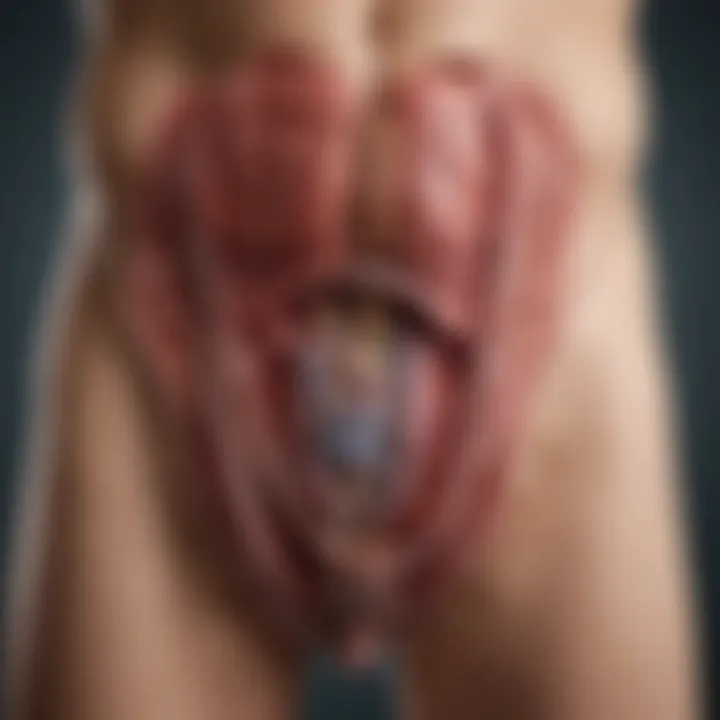Understanding Recurrent UTIs in Men: An In-Depth Examination


Intro
Recurrent urinary tract infections (UTIs) in men have been an overlooked area in medical literature. Often dismissed as a condition of the female population, men can also experience these infections with significant implications for their health. Understanding the etiology, treatment, and preventive measures is crucial for managing recurrent UTIs effectively. This article aims to provide readers with a detailed exploration of the subject, emphasizing the unique aspects affecting men.
The incidence of recurrent UTIs in men is low compared to women, but it still occurs with enough frequency to warrant attention. Factors like underlying medical conditions, anatomical differences, and lifestyle choices play a pivotal role in the frequency and severity of these infections. It is important to dissect these elements to fully comprehend how recurrent UTIs can develop in male patients.
This paper is structured to cover the causes underlying recurrent UTIs, their prevention strategies, and effective treatment options. The intended audience includes students, educators, and professionals who are keen to understand this condition with a scientific lens.
By elucidating these points, we aim to increase awareness and decrease stigma associated with recurrent UTIs in men, contributing to more informed healthcare decisions.
Prolusion to Recurrent UTIs in Men
Recurrent urinary tract infections (UTIs) represent a significant health issue, notably in men, who often face unusual complexities in their experience with this condition. Understanding the nuances of UTIs in the male population is crucial for effective diagnosis, treatment, and prevention. UTIs are not only uncomfortable but can also signal underlying health problems that require attention. Therefore, a detailed exploration of this topic is necessary for healthcare providers, researchers, and patients alike.
This section aims to highlight the importance of recognizing recurrent UTIs in men. Given that UTIs have long been considered primarily a female concern, misconceptions prevail. Men may find themselves suffering in silence because of stigma or lack of awareness. As such, studying this condition is essential to improve health outcomes and quality of life for afflicted men.
Definition of UTIs
Urinary tract infections occur when harmful bacteria enter the urinary system, affecting various components, including the bladder, urethra, and kidneys. Symptoms can vary from mild to severe, but they usually include an intense urge to urinate, burning sensation during urination, and cloudy urine. The recurrent nature of these infections poses additional challenges, as they may indicate persistent bacterial presence or anatomical issues.
Understanding and defining this medical condition is vital. Clarity helps in developing preventive measures and treatment plans that effectively address the causes.
Prevalence of UTIs in Men
While UTIs are more common in women, the prevalence in men, though lower, is not negligible. Statistics reveal that around 10% of men experience a UTI in their lifetime. Factors influencing this prevalence include age, anatomical differences, and existing health conditions.
Men over 50 years old are particularly at risk due to prostate enlargement, which can obstruct urine flow and create an ideal environment for bacteria.
The rarity of UTIs in younger men can lead to a misunderstanding that they are immune to these infections. However, recurrent episodes in any age group can indicate serious health concerns, necessitating awareness and appropriate medical intervention.
A nuanced understanding of the prevalence is important. It allows for better allocation of resources in clinical settings and highlights the need for awareness campaigns aimed at educating men on UTI risks and symptoms.
Anatomical and Physiological Considerations
Understanding the anatomical and physiological aspects of the male urinary tract is critical in examining recurrent urinary tract infections (UTIs) in men. The unique structure and function of this system can influence susceptibility to infections. This section explores these elements to provide insight into why certain men experience recurrent UTIs more than others.
Male Anatomy Overview
The male urinary tract comprises several key components, including the kidneys, ureters, bladder, and urethra.
- Kidneys: Two bean-shaped organs that filter blood and produce urine.
- Ureters: Tubes that transport urine from the kidneys to the bladder.
- Bladder: A muscular sac that stores urine until it is ready to be expelled.
- Urethra: The tube through which urine exits the body, which is longer in men compared to women.
The longer urethra is often seen as a protective factor against UTIs since it is more complicated for bacteria to travel. However, this tubular structure also presents specific challenges. For instance, the proximity of the urethra to the rectum may contribute to a higher risk of bacterial contamination. Additionally, the prostate gland, which is located just below the bladder, is crucial in the urinary and reproductive systems. Enlargement or inflammation of the prostate can affect urinary function and possibly predispose men to recurrent infections.
Unique Features of Male Urinary Tract
The male urinary tract is not only longer but also more complex in its functionality.
- Urethral Length: The average male urethra is about 18-20 cm long. This longer pathway can make it less likely for bacteria to reach the bladder quickly, yet it can still be affected by factors like obstruction or irritation.
- Prostate Influence: The prostate contributes to the production of seminal fluid. Its health is integral to urinary function. An enlarged prostate can obstruct urine flow and create conditions that foster bacterial growth.
- Hormonal Influence: Testosterone levels can also affect the urinary tract. Low levels of this hormone are associated with various urological issues, including increased risk of recurrent UTIs.
- Age Factors: As men age, changes in the bladder and prostatic tissue can occur. These changes can increase the risk of developing UTIs, making it crucial to monitor urinary health as one ages.
The relationship between anatomical structures and physiological function is complex but vital in understanding the propensity for recurrent UTIs in men.
These anatomical and physiological considerations establish a foundation for understanding the circumstances that lead to recurrent UTIs. Knowledge of these elements not only aids in research but also informs treatment and prevention strategies.
Causes of Recurrent UTIs in Men
Recurrent urinary tract infections (UTIs) in men present a significant concern, impacting quality of life and overall health. Understanding the causes behind these infections is crucial for prevention and effective treatment. Several factors contribute to the recurrence of UTIs, including bacterial influences, underlying medical conditions, and lifestyle practices. Identifying and addressing these factors can help reduce the frequency and severity of UTIs.
Bacterial Factors
Bacterial factors play a central role in the development of recurrent UTIs. The most common culprits in these infections are bacteria from the intestines, particularly Escherichia coli. This organism can easily enter the urinary tract through improper hygiene or other risk factors. It is essential to recognize that certain strains are more virulent and can lead to more severe infections.
Moreover, biofilm formation on the surface of the urinary tract can protect bacteria from the immune system and antibiotics. Understanding these aspects is critical because it informs the choice of antibiotic therapy and highlights the need for improved hygiene practices post-treatment.
Underlying Medical Conditions
Diabetes Mellitus
Diabetes mellitus is a major underlying condition that increases susceptibility to recurrent UTIs. The key characteristic of diabetes is elevated blood sugar levels, which can exacerbate infections. High glucose concentrations in urine provide a favorable environment for bacterial growth. This aspect makes diabetes particularly significant in this discussion. Individuals with diabetes often face challenges with immune response, which further complicates the management of infections. Thus, addressing diabetes management can substantially decrease UTI recurrence.


Prostate Enlargement
Prostate enlargement, or benign prostatic hyperplasia, also influences the likelihood of recurrent UTIs in men. This condition can obstruct urine flow, leading to incomplete bladder emptying. Urine retention provides a breeding ground for bacteria, increasing the risk of infection. The unique feature of prostate enlargement is its gradual onset, often going unnoticed until recurrent infections occur. Therefore, recognizing its presence and treating it timely can reduce UTI episodes significantly.
Neurological Disorders
Neurological disorders impact bladder function significantly. Conditions such as multiple sclerosis or spinal cord injuries can disrupt normal bladder control, leading to urinary retention and increased infection risk. The key characteristic of these disorders is that they affect the nervous system's ability to communicate with the bladder, complicating urination. Addressing these disorders can prove vital in reducing the incidence of recurrent UTIs, allowing for a more comprehensive approach to treatment.
Lifestyle Factors
Hygiene Practices
Hygiene practices are critical in preventing recurrent UTIs. The most important aspect is maintaining cleanliness in the genital area. Poor hygiene can facilitate bacterial migration from the rectal area to the urethra, paving the way for infection. Educating men on effective hygiene practices can be a beneficial aspect of preventing recurrent UTIs. While it may seem basic, many overlook this essential step, which has a substantial impact on urinary health.
Sexual Activity
Sexual activity can also contribute to recurrent UTIs in men. During sexual intercourse, bacteria can enter the urinary tract, leading to infection. The vulnerability may be higher in certain activities, notably anal intercourse. As a result, discussing the implications of sexual practices can be beneficial in the context of UTI prevention. This conversation helps in raising awareness and prompting preventive measures among sexually active individuals.
Fluid Intake
Fluid intake is a straightforward yet often overlooked factor in preventing UTIs. Adequate hydration helps in flushing out bacteria from the urinary tract, reducing the risk of infection. Men should aim for consistent fluid intake, especially water, to aid urinary function. This point is relevant because it emphasizes the importance of lifestyle modifications. Men can make simple adjustments that significantly impact their urinary health and reduce infection risks.
Signs and Symptoms of UTIs
The discussion of signs and symptoms related to urinary tract infections (UTIs) is crucial in understanding how they manifest, especially in men. Recognizing the symptoms early can lead to prompt diagnosis. This, in turn, allows for effective treatment and may help in preventing recurrent infections. UTIs can affect various aspects of health, hence awareness of these signs will aid individuals in seeking medical attention when necessary.
Common Symptoms
A UTI may present with a range of symptoms. Common symptoms include:
- Frequent urination: A person may feel the urge to urinate more often than usual, sometimes producing very little urine.
- Burning sensation: Pain or discomfort while urinating is a typical sign.
- Cloudy or strong-smelling urine: Changes in the urine's appearance and odor can indicate an infection.
- Pelvic pain: This may occur in the lower abdomen and is often associated with urinary discomfort.
Other potential symptoms can include fever or chills, which signal that the infection may be more severe or have spread to the kidneys. It is important for individuals to keep track of these symptoms to provide their healthcare providers with accurate information.
Symptoms Indicative of Complications
While many UTIs can be straightforward and manageable, there are specific symptoms that may indicate complications. Such symptoms warrant immediate medical attention and evaluation. These include:
- High fever: A temperature higher than 101°F can indicate a serious infection.
- Back pain: Pain in the lower back or side may suggest that the infection has moved to the kidneys.
- Nausea and vomiting: These symptoms may accompany a severe infection.
- Blood in the urine: Hematuria can be a sign of a more aggressive infection or other serious problems.
Prompt recognition of these symptoms can significantly influence outcomes. Men experiencing these signs should not delay in consulting healthcare providers to avoid potential complications.
"Recognition of symptoms in UTIs can improve the outcome and help prevent recurrent issues."
In summary, understanding the signs and symptoms of UTIs is essential for effective management, particularly in men. Early detection is key to minimizing risks and ensuring optimal health.
Diagnostic Approaches
Diagnostic approaches are essential in understanding recurrent urinary tract infections (UTIs) in men. Proper diagnosis not only aids in confirming the presence of an infection but also helps to identify its cause. This section elaborates on the types of diagnostic methods available and their significance in managing recurrent UTIs effectively. Accurate diagnosis can lead to targeted treatment strategies, minimizing the risk of further infections and improving patient quality of life.
Urinalysis
Urinalysis is a fundamental diagnostic tool used to assess the components of urine. It can provide immediate insights into the presence of bacteria, white blood cells, and other indicators of infection. During urinalysis, a sample of urine is collected and examined for visual and chemical properties, as well as microscopic examination. This non-invasive procedure is pivotal as it can quickly reveal if an infection is present and the general health of the urinary tract.
Almost every patient presenting symptoms suggesting a UTI will undergo urinalysis. Its widespread use stems from the ease and speed of the test, leading to timely diagnosis. This allows for prompt initiation of appropriate treatment, which is crucial in recurrent cases.
Urine Culture
Urine culture is another significant diagnostic method that follows urinalysis. While urinalysis gives an overview, urine culture takes this further by identifying the specific type of bacteria responsible for the infection. A urine sample is incubated in a lab to encourage the growth of any bacteria present.
This method distinguishes between different bacteria and helps to determine their sensitivity to antibiotics. Knowing the exact bacteria involved is important for selecting the most effective treatment, especially in cases where recurrent infections occur. It is critical in tailoring antibiotic therapy to the individual patient and avoiding broad-spectrum antibiotics unless necessary.
Imaging Studies
Imaging studies may be recommended when recurrent UTIs occur frequently or when complications are suspected. These studies help visualize the anatomical structures of the urinary tract, providing insights into possible structural abnormalities.
Ultrasound
Ultrasound is a non-invasive imaging technique that uses sound waves to create images of internal organs. It is particularly useful for examining the kidneys and bladder. The key characteristic of ultrasound is its ability to provide real-time images without the need for radiation, making it a safe choice for patients.
In the context of recurrent UTIs, ultrasound can help detect obstructions, stones, or abnormalities in the urinary tract that may predispose individuals to infections. Its advantages include clarity and safety; however, it may have limitations in assessing certain deep structures due to its reliance on the operator's skill and patient body type.


CT Scan
CT Scan, or computed tomography, offers a more detailed view than ultrasound. It uses X-rays to produce cross-sectional images of the body. This method is beneficial in identifying complex issues not visible on a standard ultrasound.
In cases of recurrent UTIs, a CT scan can help to visualize kidney stones or tumors in the urinary tract, determining the need for surgical intervention or specialized treatment. The unique feature of a CT scan is its speed and high-resolution images, which can provide immediate information for urgent cases. However, its use of ionizing radiation does present a consideration, particularly for patients requiring frequent imaging.
Treatment Options
The treatment options for recurrent urinary tract infections (UTIs) in men are critical in addressing both the immediate infection and preventing future occurrences. Understanding these options enables better management of the condition and can significantly impact a patient's quality of life. This section will examine both antibiotic therapy and non-antibiotic treatments, providing insight into their effectiveness and considerations.
Antibiotic Therapy
Antibiotic therapy remains the cornerstone of treatment for UTIs. It targets the bacterial infection directly, offering prompt relief from symptoms and eradicating the pathogen responsible for the infection.
Short-Course Therapy
Short-course therapy typically involves the use of antibiotics for a period of three to seven days. One of the key characteristics of this approach is its efficiency in managing uncomplicated UTIs. This method is a popular choice due to its ease of administration and ability to minimize potential side effects, which can accompany longer regimens.
Short-course therapy is beneficial because it often leads to quicker resolution of symptoms, allowing men to return to their normal activities without prolonged effects on their health. However, a notable feature is that this approach may not be as effective for all patients, especially those with recurrent infections or underlying health issues. The main advantage lies in its simplicity, while a potential disadvantage is that some men might experience frequent relapses even after such treatment.
Long-Term Prophylaxis
Long-term prophylaxis involves using a lower dose of antibiotics over an extended period, usually a few months. This method can help prevent recurrent infections in men who experience frequent UTIs. A significant characteristic of this strategy is its preventative nature, balancing the need to keep bacteria at bay while reducing the chances of developing antibiotic resistance.
This approach can be beneficial for men who have chronic UTIs, contributing positively to their overall health and well-being. Still, one unique feature of long-term prophylaxis is the need for careful monitoring by healthcare professionals to mitigate risks associated with prolonged antibiotic use. Thus, the advantage here is a decreased incidence of infections, while the disadvantage may include the possible development of antibiotic resistance or side effects from ongoing antibiotic exposure.
Non-Antibiotic Treatments
Non-antibiotic treatments are gaining attention as adjuncts or alternatives to traditional antibiotic therapies. These methods can offer ways to enhance recovery and reduce the frequency of UTIs without relying solely on medication.
Cranberry Supplements
Cranberry supplements are renowned for their potential role in preventing UTIs, specifically by preventing bacteria from adhering to the urinary tract walls. A key characteristic of cranberry supplements is their natural origin, appealing to men looking for alternatives to conventional medications. This option is popular due to the increasing interest in natural health remedies.
The unique feature of cranberry supplements lies in their ability to maintain urinary health while being largely safe for consumption. The advantages include fewer side effects compared to antibiotics. On the downside, their effectiveness can vary, and they may not work for everyone. Additionally, reliance solely on cranberry supplements without other preventive measures might not be sufficient in some cases.
Probiotics
Probiotics are live microorganisms that provide health benefits when consumed in adequate amounts. They contribute to maintaining a healthy balance of the microbiome in the urinary tract, potentially reducing the incidence of recurrent UTIs. A significant characteristic of probiotics is their multifaceted role in enhancing the immune system and overall gut health, making them a versatile addition to treatment plans.
The appeal of probiotics lies in their gentle nature and minimal side effects, positioning them as a beneficial choice for those wary of antibiotics. A unique feature is their capacity to replenish beneficial bacteria after antibiotic treatment, which is crucial for preventing the overgrowth of harmful bacteria. However, while the advantages are clear, the effectiveness of probiotics can vary significantly among individuals, and more research is necessary to determine optimal strains and dosages for UTI prevention.
Prevention Strategies
Preventing recurrent urinary tract infections (UTIs) in men is crucial to enhancing quality of life and reducing the frequency and severity of infections. Different approaches, including hygiene practices and behavioral modifications, can help mitigate the risks associated with UTIs. Education on these topics serves as a proactive measure that can empower individuals to adopt habits that encourage urinary tract health.
Hygiene Practices
Proper hygiene is fundamental in preventing RTIs. Men should understand that simple steps can significantly reduce the likelihood of infection. Here are some key points to consider:
- Regular Washing: Men should wash the genital area daily with mild soap and water. This decreases the buildup of bacteria.
- Front to Back Wiping: After defecation, wiping from front to back helps prevent fecal bacteria from spreading to the urethra.
- Avoiding Irritants: Products such as scented soaps, colognes, or powders should be avoided, as they can irritate the urinary tract.
Integrating these hygiene practices into daily routines can create a protective barrier against recurrent UTIs, underscoring the importance of personal cleanliness in urinary health.
Behavioural Modifications
Adopting lifestyle changes can also contribute greatly to the prevention of recurrent UTIs. Two key areas to focus on are fluid intake recommendations and urination habits. These practices not only promote urinary tract health but also enhance overall well-being.
Fluid Intake Recommendations
Maintaining adequate hydration is vital in the battle against UTIs. The key aspect of fluid intake is ensuring sufficient daily water consumption. Hydration leads to more frequent urination, which may help flush out bacteria from the urinary tract. The general recommendation is to aim for about 8-10 cups (2 to 3 liters) of water daily.
- Key Characteristic: Staying well-hydrated dilutes urine and creates a less favorable environment for bacteria.
- Benefits: Increased fluid intake may strengthen urinary tract defenses and lower the risk of infection.
- Unique Feature: Individual needs may vary based on factors like activity levels, climate, and overall health.
It's important to remember that excessive intake can lead to frequent urination, which can be inconvenient. Therefore, balance is crucial in this strategy.
Urination Habits
Regular urination habits also play a significant role in UTIs prevention. Men should aim to urinate when they feel the urge rather than holding it in for extended periods. This habit not only helps keep the urinary tract clear but also reduces the chances of urinary stasis, which can serve as a breeding ground for bacteria.
- Key Characteristic: Regular urination prevents prolonged exposure of the urinary tract to potential pathogens.
- Benefits: It promotes urinary health and decreases infection frequency.
- Unique Feature: Awareness of individual patterns is essential, as it may help to identify factors contributing to recurring infections.


Emerging Research
Emerging research plays a crucial role in understanding recurrent urinary tract infections (UTIs) in men. It examines new dimensions, such as the microbiome's impact and innovative treatment modalities. This evolving landscape is essential for enhancing patient care and outcomes.
In recent years, there has been increased interest in how the microbiome influences UTI occurrences. The microbiome comprises trillions of microorganisms residing in the body, including the urinary tract. Disruptions in this microbial community may increase susceptibility to reinfections. By studying these interactions, researchers can identify target areas for therapeutic intervention.
Furthermore, exploring novel therapeutic approaches provides insight into alternatives to traditional treatments. Traditional antibiotic therapies can lead to resistance and recurrent infections. Thus, innovative strategies are necessary and demand the attention of researchers and clinicians alike.
Microbiome and UTIs
The study of the microbiome's role in urinary health has opened up new avenues for research. Evidence suggests that a balanced microbiome may help prevent recurrent UTIs in men by outcompeting pathogenic bacteria. For instance, certain strains of Lactobacillus are known to inhibit the growth of harmful bacteria in the urinary tract.
The correlation between microbial communities and UTI susceptibility is becoming clearer. For instance, a 2021 study published in the Journal of Clinical Microbiology highlighted that men with recurrent UTIs exhibited different urinary microbiome profiles compared to those without such issues. A diverse and healthy microbiome may correlate with lower UTI rates. This point necessitates more research to investigate potential probiotic treatments that could restore the microbiome balance.
Ultimately, understanding the microbiome's role highlights biological intricacies that have previously been overlooked. Its investigation could lead to preventive strategies that diverge from conventional antibiotic therapies.
Novel Therapeutic Approaches
Beyond microbiome research, the exploration of novel therapeutic methods is critical in managing recurrent UTIs. As antibiotic resistance rises, alternative strategies are urgently needed. Some emerging treatments include the use of vaccines and immunotherapies aimed at bolstering the body's natural defenses against UTI pathogens.
One promising area is the development of a vaccine that targets specific bacterial strains, such as Escherichia coli, responsible for the majority of UTI cases. Successful vaccination could reduce the incidence of recurrent infections.
Additionally, some studies are looking into the effectiveness of natural compounds, such as D-Mannose, a sugar that inhibits bacterial adhesion in the urinary tract. Preliminary results indicate it may reduce recurrent UTI episodes.
Emerging research signifies a shift towards understanding underlying biological mechanisms, ultimately guiding effective preventive and treatment options for recurrent UTIs in men.
Impact of Recurrent UTIs on Quality of Life
Recurrent urinary tract infections (UTIs) can significantly impact a man's quality of life. This topic is crucial in understanding not only the medical aspects but also the emotional and economic implications. Individuals suffering from recurrent UTIs often face persistent discomfort and anxiety, affecting both their physical and psychosocial wellbeing. Understanding these effects is essential for offering better treatment options and support to those impacted.
Psychosocial Effects
The psychological impact of recurrent UTIs cannot be underestimated. Many men experience anxiety and stress related to the unpredictability of their symptoms. The fear of experiencing urinary urgency, pain, and potential social embarrassment can lead to social isolation. In severe cases, individuals may develop depressive symptoms that further complicate their health.
Men with recurrent UTIs often report reduced participation in social, occupational, and recreational activities. They might avoid situations where clean restroom facilities are not readily available. This avoidance behavior can lead to strained relationships and decreased productivity at work.
Supporting men dealing with these infections involves more than just addressing the physical symptoms. Providing resources for emotional support, such as counseling services, can help in managing the psychosocial burdens associated with recurrent UTIs.
Economic Burden
The economic impact of recurrent UTIs is substantial, influencing both individual finances and broader healthcare costs. Patients often incur high medical expenses due to frequent doctor visits, diagnostic tests, and long-term treatments. Each case of UTI requires a different approach, and costs can pile up quickly, given that some men need repeated courses of antibiotics or other therapies.
Healthcare systems also bear a heavy burden. Increased incidence of UTIs leads to a greater demand for medical resources, which can strain healthcare services. There is also a loss of productivity as affected individuals take time off work to deal with their symptoms or attend medical appointments.
According to research, recurrent UTIs can cost the healthcare system millions annually due to both direct medical costs and lost work productivity.
Addressing the economic burden involves not only treatment but also education about prevention and management strategies. This can lead to a decrease in the frequency of infections and, ultimately, a reduction in associated costs.
Understanding the psychosocial and economic implications of recurrent UTIs is vital for developing comprehensive treatment and support strategies. By recognizing the multifaceted impact of this condition, healthcare providers can better assist men in managing their health and enhance their overall quality of life.
The End
Understanding recurrent urinary tract infections (UTIs) in men is crucial for various reasons. First, it helps clinicians recognize the complexity of this health issue, which is often seen as a minor concern. This misunderstanding can lead to inadequate treatments and ongoing health problems. It is vital to appreciate that recurrent UTIs can affect physical health, mental well-being, and overall life quality.
In this article, we examined the causes, prevention strategies, and treatment options surrounding recurrent UTIs. This comprehensive analysis enables health professionals to tailor their approaches, addressing the specific needs and concerns of male patients. Moreover, knowledge of underlying conditions like diabetes and prostate enlargement can significantly enhance the management of recurrent UTIs.
Here are some key elements discussed:
- Importance of awareness about UTI symptoms and their recurrence.
- Tailored treatment options based on individual health situations.
- Preventative strategies that can reduce the incidence of UTIs.
- Emerging research that holds promise for more effective treatments.
The health implications extend beyond immediate symptoms and vagueness around male UTIs can foster stigma and silence. Therefore, fostering awareness and making informed decisions about urological health can empower individuals, leading to better health outcomes.
Addressing recurrent UTIs is not just about treatment; it’s about enhancing quality of life for men who experience them. With a more profound understanding of this topic, practitioners can engage in proactive dialogues with patients, ultimately leading to improved management and support.
Summary of Key Points
The key points outlined in this article can be summarized as follows:
- Recurrent UTIs are significant and often overlooked in men. Their prevalence indicates a need for strong medical focus.
- Underlying conditions like diabetes mellitus and prostate problems play a big role in the recurrence of UTIs.
- Lifestyle changes such as better hygiene practices and increased fluid intake can be effective preventative strategies.
- Treatment varies, including antibiotics and non-antibiotic interventions like cranberry supplements.
- Emerging studies point towards new approaches to understanding and treating UTIs.
Future Directions in Research
As research progresses, several key areas may provide new insights into managing and preventing recurrent UTIs. These include:
- Microbiome Research: Understanding how gut and urinary tract microbiomes interact could lead to novel therapeutic approaches.
- Longitudinal Studies: More extensive, long-term studies are needed to comprehend the recurrence pattern and its predictors better.
- Personalized Medicine: Future research might focus on tailoring treatment to an individual's genetic, biochemical, and lifestyle factors. This can optimize interventions.
- Recurrence Mechanisms: Investigating why some men are more susceptible to recurrent UTIs than others could clarify targeted preventive measures.
Overall, a comprehensive understanding of recurrent UTIs will benefit both health professionals and patients alike, setting the stage for innovative approaches and improved treatment outcomes.







